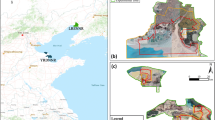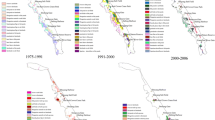Abstract
Habitat loss and fragmentation are mainly associated with population decrease of endangered species and biodiversity loss. The habitat suitability maps of red-crowned crane (Grus japonensis) in 1992, 1999 and 2006 were produced by using Ecological Niche Suitability Model (ENSM) in Yellow River Delta Nature Reserve (118°33′-119°20′E longitude, 37°35′-38°12′N latitude), Shandong Province, China. Based on the habitat suitability maps, the causation and change law of habitat loss and fragmentation of red-crowned crane were analyzed by selecting a series of landscape pattern indices. Results showed that due to scarcities of fresh water sources, habitat suitability of red-crowned crane in 1999 was inferior to that in 1992 and 2006 no matter whether human disturbances existed or not. Besides, human disturbance activities, especially road disturbances, increased rapidly during the period of 1992–2006. This worsened the habitat loss and fragmentation of red-crowned crane, and led to degrading habitat suitability of red-crowned crane in 2006, compared with that in 1992. In conclusion, fresh water sources and human disturbance activities are the two main factors that drive the habitat suitability change of red-crowned crane.
Similar content being viewed by others
References
Andren H. 1994. Effects of habitat fragmentation on birds and mammals in landscapes with different proportions of suitable habitat-a review. Oikos, 71(3): 355–366.
Burkey TV. 1995. Extinction rates in archipelagoes: implications for population in fragmented habitats. Conservation Biology, 9(3): 527–541.
Chen Liding, Liu Xuehua and Fu Bojie. 1999. Evaluation on Giant Panda habitat fragmentation in Wolong nature reserve. Acta Ecological Sinica, 19(3): 291–297. (In Chinese)
Cushman SA. 2006. Effects of habitat loss and fragmentation on amphibians: A review and prospectus. Biological Conservation, 128(2): 231–240.
Dooley JL, Bowers MA. 1998. Demographic responses to habitat Fragmentation: experimental tests at the landscape and patch scale. Ecology, 79(3):968–980.
Fahrig L. 1997. Relative effects of habitat loss and fragmentation on popula tion extinction. Journal of Wildlife Management, 61(3): 603–610.
Fahrig L. 2003. Effects of habitat fragmentation on biodiversity. Annual Review of Ecology Evolution and Systematics, 34: 487–515.
Flather CH, Bevers M. 2002. Patchy reaction-diffusion and population abundance: the relative importance of habitat amount and arrangement. The American Naturalist, 159(1): 40–56.
Gibbs JP. 2000. Wetland loss and Biodiversity conservation. Conservation Biology, 14(1): 314–317.
Gustafson EJ, Parker GR. 1992. Relationships between landcover proportion and indices of landscape spatial pattern. Landscape Ecology, 7(2): 101–110
He HS, DeZonia BE, Mladenoff DJ. 2000. An aggregation index (AI) to quantify spatial patterns of landscapes. Landscape Ecology, 15(7):591–601.
IUCN. 2007. 2007 IUCN Red List of threatened species. Available at the following website: http://www.iucn.org/themes/ssc/redlist.htm
Laurance WF, Lovejoy TE, Vasconcelos HL, et al. 2002. Ecosystem decay of Amazonian forest fragments: a 22 year investigation. Conservation Biology, 16(3): 605–618.
Li Fangman, Li Peixun. 1998. A comparative study on territories of white-naped crane and red-crowned crane. Acta Zoologica Sinica, 44(1):109–111. (In Chinese)
Li Feng, Yang Hongjun, Zhang Honghai. 1999. The nest-site selection by red-crowned crane in the Zalong wetland. Journal of Northeast Forestry University, 27(6): 57–60. (In Chinese)
Li Wenjun, Wang Zijian. 2000. A winter habitat model for red-crowned crane. Chinese Journal of Applied Ecology, 11(6): 839–842. (In Chinese)
Li Wenjun, Ma Zhijun, Wang Zijian, Tang Hongxiao, Wang Hui, Liu Xiping. 1999. A study on influential aspects relevant with habitat in natural reserve. Acta Ecologica Sinica, 19(3): 427–430. (In Chinese)
Li Wenjun, Wang Zijian, Ma Zhijun, Tang Hongxiao, Wang Hui, Liu Xiping. 1997. The study of distribution of red-crowned crane’s winter habitat in Yancheng nature reserve. Man and biosphere, 4(3): 3–7. (In Chinese)
Li Xiaomin. 2002. The present status and conservation of red-crowned crane in Halahai wetland, Heilongjiang, China. Chinese Journal of Zoology, 37(1):64–66. (In Chinese)
Liu Bai. 1990. Winter numbers distribution of red-crowned crane on seaboard of yangcheng of Jiusu Province. Acta Ecologica Sinica, 10(3): 284–285. (In Chinese)
Liu Zhensheng, Wu Jianping, Li Xiaomin, Teng Liwei, Wang Xiaoming, Guo Wenli, Qi Zhi, Yao Hongwei. 2001. Behavior of red-crowned crane during breeding season in zhalong nature reserve. Journal of Northeast Forestry University, 29(6): 92–95. (In Chinese)
Ma Zhijun, Liu Xiping. 1998. Habitat change and suitability of red-crowned crane in Yancheng biosphere nature reserve. Man and Biosphere, 5(2): 5–8. (In Chinese)
McGarigal K, Cushman SA, Neel MC. et al. 2002. FRAGSTATS Documentation, Available at the following website: http://www.umass.edu/landeco/research/fragstats/documents/fragstats_documents.html.
Odum EP. 1971. Fundamental of Ecology. Philadelphia P H.A.B: Saunder Company.
O’Neill RV, Krummel JR, Gardne, RH. 1988. Indices of landscape pattern. Landscape Ecology, 1: 153–162.
Ouyang Zhiyun, Wang Rusong. 1996. Ecological niche suitability model and its application in land suitability assessment. Acta Ecologica Sinica, 16(2):113–120. (In Chinese)
Schmiegelow FKA, Monkkonen M. 2002. Habitat loss and fragmentation in dynamic landscapes: avian perspectives from the boreal forest. Ecological Application, 12(2): 375–389.
Stephens SE, Koons DN, Rotella JJ, Willey DW. 2003. Effects of habitat fragmentation on avian nesting success: a review of the evidence at multiple spatial scales. Biological Conservation, 115(1): 101–110.
Su Ying, Hu Yuanman, Guo Dufa, Shan Kai, Zhu Shuyu, Wang Lidong. 2004. The change of habitat suitable for the red-crowned crane in Yellow River Delta. Chinese Journal of Zoology, 39(3): 33–41. (In Chinese)
Su Ying, Hu Yuanman, Leng Wenfang, Zhu Shuyu, Shan Kai. 2006. The habitat selection of red-crowned crane at autumn and winter in Yellow River Delta. Chinese Journal of Ecology, 25(8): 954–958. (In Chinese)
Wan Dongmei, Gao Wei, Wang Qiuyu, Wang Haitao, Liu Mingyu. 2002. Effects of habitat fragmentation on nesting site selection of red-crowned crane. Chinese journal of applied ecology, 13(5): 581–584. (In Chinese)
Wilcove DS, Rothstein D, Dubow J, Philips A, Losos E. 1998. Quantifying threats to imperiled species in the Unite States. BioScience, 48(8): 607–615.
Wu Jianping, Liu Zhensheng, Li Xiaomin, teng Liwei, qiu Fuchen, wang Xiaoming, Qi Zhi, Yao Hong Wei, Guo Wenli. 2002. Breeding Behavior of red-crowned crane in zalong reserve. Chinese Journal of Zoology, 37(5):42–46. (In Chinese)
Xiao Duding, Hu Yuanman, Li Xiuzhen. 2001. Landscape ecology research at wetland surrounding Bohai sea delta. Beijing: Science Press, 106–107. (In Chinese)
Yang Likai. 2005. Effect of agricultural eco-environment from Huanghe River cessation in huanghe River delta area and its countermeasure. China Environment Management, 3: 27–30. (In Chinese)
Zhang Peiyu, Li Guizhi. 2001. Study of red-crowned crane about its winter quarters and measures of protecting. Journal of Biology, 18(2): 9–10. (In Chinese)
Zhang Yanhong, Deng Wei, Zhang Shuwei. 2006. The spatial structure analysis of the red-crown crane’s habitat in xianghai national nature reserve based on RS and GIS techniques. Acta Ecologica Sinica, 26(11):3725–3731. (In Chinese)
Zhao Yangmao. 1995. Scientific survey of the Yellow River Delta Nature Reserve. Beijing: China Forestry Press, 115–117. (In Chinese)
Author information
Authors and Affiliations
Corresponding author
Additional information
Foundation project: the research was supported by National Natural Science Foundation (No. 40771172) and Knowledge innovation project of the Chinese Academy of Sciences (No. kzcx2-yw-308).
Rights and permissions
About this article
Cite this article
Cao, Mc., Liu, Gh. Habitat suitability change of red-crowned crane in Yellow River Delta Nature Reserve. Journal of Forestry Research 19, 141–147 (2008). https://doi.org/10.1007/s11676-008-0024-5
Received:
Accepted:
Published:
Issue Date:
DOI: https://doi.org/10.1007/s11676-008-0024-5




